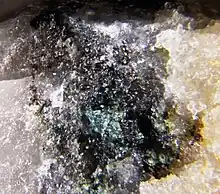| Mohite | |
|---|---|
 | |
| General | |
| Category | Sulfide mineral |
| Formula (repeating unit) | Cu2SnS3 |
| IMA symbol | Moh[1] |
| Strunz classification | 2.CB.15b |
| Crystal system | Monoclinic |
| Crystal class | Domatic (m) (same H-M symbol) |
| Space group | Cc |
| Unit cell | a = 6.64 Å, b = 11.51 Å, c = 19.93 Å; β = 109.75°; Z = 4 |
| Identification | |
| Color | Gray with a greenish tint |
| Crystal habit | Microscopic grains |
| Mohs scale hardness | 4 |
| Luster | Metallic |
| Streak | Gray |
| Diaphaneity | Opaque |
| Specific gravity | 4.86 (calculated) |
| References | [2][3][4] |
Mohite is a copper tin sulfide mineral with the chemical formula Cu2SnS3. It is colored greenish gray and leaves a gray streak. It is opaque and has metallic luster. Its crystal system is triclinic pedial. It is rated 4 on the Mohs Scale and has a specific gravity of 4.86.
Discovery and occurrence
Mohite was first described in 1982 for an occurrence in the Chatkal-Kuramin Mountains of eastern Uzbekistan. It was named after Günter Harald Moh (1929–1993), University of Heidelberg.[3] It is of hydrothermal origin and occurs associated with tetrahedrite, famatinite, kuramite, mawsonite and emplectite in the type locality in Uzbekistan.[2] It has also been reported from Salamanca Province, Spain; the Organullo Mining District of Salta Province, Argentina; and the Delamar Mountains of Lincoln County, Nevada, US.[2][3]
References
- ↑ Warr, L.N. (2021). "IMA–CNMNC approved mineral symbols". Mineralogical Magazine. 85: 291–320.
- 1 2 3 Handbook of Mineralogy
- 1 2 3 Mohite on Midat.org
- ↑ Webmineral data